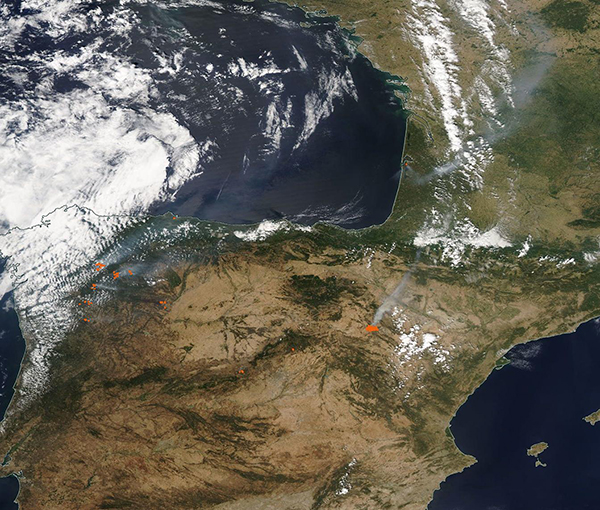Images
July 21, 2022 - Fires in Europe
Tweet
Extreme heat and ongoing drought spurred dozens of wildfires across western Europe in mid-July 2022. Temperatures in the United Kingdom reached all-time highs, triggering a declaration of national emergency. According to Wildfire Today, six locations, including London Heathrow, hit 104˚F (40˚C) on July 19, shattering the previous record of 101.7˚F (38.7˚C) set in 2019. Eleven fires were reported in London, ten of which were vegetation fires.
Soaring temperatures and wildfires aren’t limited to the United Kingdom but stretch over a wide swath. For example, in Biarritz, located in southwest France, temperatures recently peaked close to 108˚F (42˚C) as several major wildfires burned in forested areas south of Bordeaux and near the Mediterranean coast. This story was the MODIS Image of the Day on July 18 and can be viewed here.
On July 19, 2022, the Moderate Resolution Imaging Spectroradiometer (MODIS) on board NASA’s Aqua satellite acquired a true-color image highlighting wildfires and smoke across parts of the Iberian Peninsula and France. Each red “hot spot” marks an area where the thermal bands on the instrument detected high temperatures. When combined with typical smoke, as in this image, such hot spots are diagnostic for actively burning fires.
More than a dozen fires can be seen burning across the image, with the largest cluster of individual fires located in Galicia, Spain and Murça, Portugal. A very large fire was located near Ateca, Spain. Comparison MODIS images that show the rapid growth of this blaze were published by NASA Earthdata website as the Worldview Image of the Week on July 19. That story and images can be found
here. Looking northward, multiple fires are continuing to burn in France. Italy and Greece (not seen in this image) have also reported major wildfires in recent days.
Image Facts
Satellite:
Aqua
Date Acquired: 7/19/2022
Resolutions:
1km (304.8 KB), 500m (1 MB), 250m (3.4 MB)
Bands Used: 1,4,3
Image Credit:
MODIS Land Rapid Response Team, NASA GSFC
Tweet
Extreme heat and ongoing drought spurred dozens of wildfires across western Europe in mid-July 2022. Temperatures in the United Kingdom reached all-time highs, triggering a declaration of national emergency. According to Wildfire Today, six locations, including London Heathrow, hit 104˚F (40˚C) on July 19, shattering the previous record of 101.7˚F (38.7˚C) set in 2019. Eleven fires were reported in London, ten of which were vegetation fires.
Soaring temperatures and wildfires aren’t limited to the United Kingdom but stretch over a wide swath. For example, in Biarritz, located in southwest France, temperatures recently peaked close to 108˚F (42˚C) as several major wildfires burned in forested areas south of Bordeaux and near the Mediterranean coast. This story was the MODIS Image of the Day on July 18 and can be viewed here.
On July 19, 2022, the Moderate Resolution Imaging Spectroradiometer (MODIS) on board NASA’s Aqua satellite acquired a true-color image highlighting wildfires and smoke across parts of the Iberian Peninsula and France. Each red “hot spot” marks an area where the thermal bands on the instrument detected high temperatures. When combined with typical smoke, as in this image, such hot spots are diagnostic for actively burning fires.
More than a dozen fires can be seen burning across the image, with the largest cluster of individual fires located in Galicia, Spain and Murça, Portugal. A very large fire was located near Ateca, Spain. Comparison MODIS images that show the rapid growth of this blaze were published by NASA Earthdata website as the Worldview Image of the Week on July 19. That story and images can be found here. Looking northward, multiple fires are continuing to burn in France. Italy and Greece (not seen in this image) have also reported major wildfires in recent days.
Image Facts
Satellite:
Aqua
Date Acquired: 7/19/2022
Resolutions:
1km (304.8 KB), 500m (1 MB), 250m (3.4 MB)
Bands Used: 1,4,3
Image Credit:
MODIS Land Rapid Response Team, NASA GSFC




